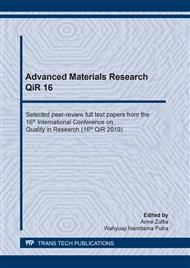[1]
H. U. Guo-rong, Z. Xin-long, and P. Zhong-dong, Preparation and electrochemical performance of tantalum-doped lithium titanate as anode material for lithium-ion battery,, Transactions of Nonferrous Metals Society of China, vol. 21, no. 10, p.2248–2253, (2011).
DOI: 10.1016/s1003-6326(11)61003-0
Google Scholar
[2]
R. Wen, Nanostructured Li4Ti5O12 as Anode Material for Lithium Ion Batteries,, M.Sc Thesis, Faculty of Science, The University of New South Wales, (2012).
Google Scholar
[3]
T. Nordh, Li4Ti5O12 as an anode material for Li ion batteries in situ XRD and XPS studies,, Uppsala Universitet Thesis, p.1–40, (2013).
Google Scholar
[4]
M. Halim, C. Hudaya, A.-Y. Kim, and J. K. Lee, Phenyl-rich silicone oil as a precursor for SiOC anode materials for long-cycle and high-rate lithium ion batteries,, Journal of Materials Chemistry A, vol. 4, no. January, p.2651–2656, (2016).
DOI: 10.1039/c5ta09973k
Google Scholar
[5]
B. Priyono, N. C. Egieara, A. Z. Syahrial, C. Hudaya, A. Subhan, and H. Jodi, The effect of activated carbon and silicon oxycarbide as anode materials on lithium-ion battery,, E3S Web of Conferences, vol. 67, p.03027, (2018).
DOI: 10.1051/e3sconf/20186703027
Google Scholar
[6]
J. Jin, S.-Z. Huang, J. Liu, Y. Li, L.-H. Chen, Y. Yu, H.-E. Wang, C. P. Grey, and B.-L. Su, Phases Hybriding and Hierarchical Structuring of Mesoporous TiO 2 Nanowire Bundles for High-Rate and High-Capacity Lithium Batteries,, Advanced Science, vol. 2, no. 7, p.1–11, (2015).
DOI: 10.1002/advs.201500070
Google Scholar
[7]
C. H. Hong, A. Noviyanto, J. H. Ryu, J. Kim, and D. H. Yoon, Effects of the starting materials and mechanochemical activation on the properties of solid-state reacted Li4Ti5O12 for lithium ion batteries,, Ceramics International, vol. 38, no. 1, p.301–310, Jan. (2012).
DOI: 10.1016/j.ceramint.2011.07.007
Google Scholar
[8]
Y. J. Gu, Z. Guo, and H. Q. Q. Liu, Structure and electrochemical properties of Li4Ti5O12 with Li excess as an anode electrode material for Li-ion batteries,, Electrochimica Acta, vol. 123, p.576–581, Mar. (2014).
DOI: 10.1016/j.electacta.2013.12.159
Google Scholar
[9]
C. G. Pantano, C. G. Pantano, A. K. Singh, A. K. Singh, H. Zhang, and H. Zhang, Silicon Oxycarbide Glasses,, Journal of Sol-Gel Science and Technology, vol. 14, p.7–25, (1999).
DOI: 10.1023/a:1008765829012
Google Scholar
[10]
H. Yan, Z. Zhu, D. Zhang, W. Li, and Qilu, A new hydrothermal synthesis of spherical Li4Ti5O12 anode material for lithium-ion secondary batteries,, Journal of Power Sources, vol. 219, p.45–51, (2012).
DOI: 10.1016/j.jpowsour.2012.07.023
Google Scholar
[11]
R. Shanmugam and W. Lai, Study of Transport Properties and Interfacial Kinetics of Na2/3[Ni1/3MnxTi2/3-x]O2 (x = 0.1/3) as Electrodes for Na-Ion Batteries,, Journal of the Electrochemical Society, vol. 162, no. 1, pp. A8–A14, (2014).
DOI: 10.1149/2.0201501jes
Google Scholar
[12]
X. Sun, M. Hegde, Y. Zhang, M. He, L. Gu, Y. Wang, J. Shu, P. V. Radovanovic, and B. Cui, Structure and electrochemical properties of spinel Li4Ti5O12nanocomposites as anode for lithium-ion battery,, International Journal of Electrochemical Science, vol. 9, no. 4, p.1583–1596, (2014).
Google Scholar
[13]
A. Z. Syahrial, F. Aldy, B. Priyono, and A. Subhan, Enhanced electrochemical performances of Li4Ti5O12/Sn composites anode via sol-hydrothermal method for lithium ion batteries,, IOP Conference Series: Earth and Environmental Science, p.0–7, (2018).
DOI: 10.1088/1755-1315/105/1/012114
Google Scholar
[14]
A. Z. Syahrial, R. Satria, B. Priyono, and A. Subhan, Effect of nano Si addition on synthesized LTO for lithium battery anode,, in IOP Conference Series: Earth and Environmental Science, 2018, vol. 105, no. 1.
DOI: 10.1088/1755-1315/105/1/012107
Google Scholar
[15]
X. Hao and B. M. Bartlett, Li4Ti5O12 nanocrystals synthesized by carbon templating from solution precursors yield high performance thin film Li-ion battery electrodes,, Advanced Energy Materials, vol. 3, no. 6, p.753–761, (2013).
DOI: 10.1002/aenm.201200964
Google Scholar


